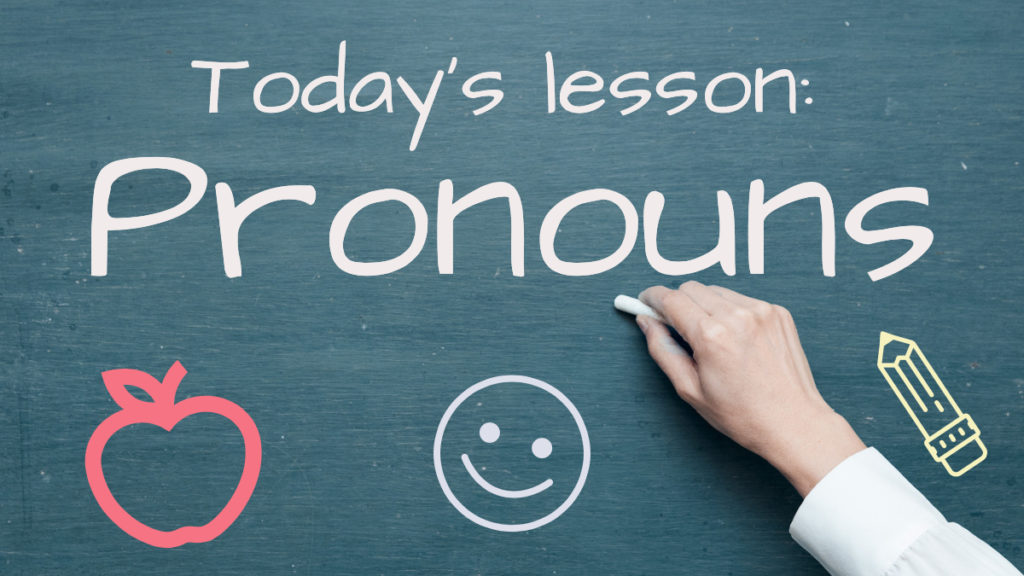 Good morning, class! Alas, summer came to an end far too quickly, and children everywhere are once again at their studies.
Good morning, class! Alas, summer came to an end far too quickly, and children everywhere are once again at their studies.
Can you smell the notebook paper and pencil shavings, the hint of chalk dust in the air? Do you hear the crackle of a brand new vinyl three-ring binder? Can you feel the heft of a textbook in your hands as you excitedly open to chapter one?
And, of course, the inevitable paper cuts as you attempt to fold that unwieldy manila textbook cover to just the right size.
Ah, the memories . . . so poignant, so richly satisfying, so–
You there on the front row, are you nodding off again? I would hate to have to send you to the principal’s office.
Shall we begin? Today’s lecture is on the subject of pronouns. Pronouns, simply put, are words that stand in for nouns. If we did not have pronouns, conversation would become quite redundant. For example:
Pronouns, simply put, are words that stand in for nouns. If we did not have pronouns, conversation would become quite redundant. For example:
On Mary’s way to Mary’s car, Mary discovered a mouse and asked Mary’s husband to kill the mouse.
Let’s see how substituting appropriate pronouns can make this sentence read more naturally:
On Mary’s way to her car, she discovered a mouse and asked her husband to kill it.
The word the pronoun refers back to is called the antecedent. “Mary,” in this case, is the antecedent of “her” and “she”; “mouse” is the antecedent of “it.”
Where writers often run into trouble is by using pronouns without clearly indicating their antecedents, or omitting an antecedent that is essential to the meaning of the sentence or paragraph.
Can you identify the problems with these sentences? (Feel free to share your thoughts in the comments.)
Zoë set food down for the cat, but the dog ate it.
Joe told Rich he would have to buy the book.
Bryan thought it was fun.
Grammar requires that the antecedent and the word it refers to must agree in gender, in number, and in person.
With regard to gender, males take male pronouns (he, him, his); females take female pronouns (she, her, hers); gender-neutral nouns take it and its.
Number refers to whether a noun is singular or plural. If the antecedent is singular, a singular pronoun is required, etc., etc.
Person indicates to whom the pronoun refers. First person refers to the speaker (I, me, we, us, my, mine). Second person refers to the person spoken to (you, your, yours). Third person refers to someone or something being spoken about (he, she, it, him, her, they, them, their, theirs).
All perfectly clear? Did I see a hand raised for a question? Oh, Myra, it’s you. You’ve been trying to ignore me for so long that I almost didn’t recognize you.
“Yes, GQ, it’s me. Sorry, I mean, it is I. I wonder if you’d address the issue of the generic their, they thing. You know, when the gender of the singular antecedent is ambiguous.”
Of course, and congratulations on your excellent vocabulary. In casual conversation, it’s more natural and generally acceptable (unfortunately) to use the plural they or their, even when the antecedent is singular. For example:
Each player at the miniature golf course kept their own scorecard.
Player is singular, but we don’t know if these people are male, female, or a few of each. Now, I must state for the record that I seldom play miniature golf, and when I do, I prefer that someone else handle the scorekeeping. However, I do know a thing or two about pronouns and therefore would urge you, when confronted with an occasion to misuse they or their with a singular antecedent, to consider the grammatically correct alternative:
Each player at the miniature golf course kept his or her own scorecard.
Or you could simply rephrase the sentence so as to remove the temptation entirely:
The miniature golf players each kept their own scorecards.
And now I shall turn my attention to another touchy issue involving pronouns–in this case, the possessive form. But first, does everyone know what a gerund is? Simply stated, a gerund is the -ing form of a verb when the word is used as a noun.
Writing is hard work. (subject of the sentence)
A well-developed story requires brainstorming. (direct object of the sentence)
Now, when you must refer to the activity as it is performed by someone, the possessive noun or pronoun should correctly come into play.
Myra’s brainstorming took longer than she anticipated, resulting in her needing to write the book much more quickly.
“I’m grateful for your finding my grammar book,” the student said.
For further explanation of gerunds and possessives, please see this post from another grammar resource: http://www.english-for-students.com/Possessives-with-Gerunds.html
Perhaps I should draw today’s lecture to a close before I completely overwhelm your poor, tired brains. However, I assure you, we will most certainly resume this discussion in a future class, for we have barely scratched the surface of proper pronoun use.
Let’s conclude with a short quiz. Please choose the correct pronoun in each of the following sentences:
1. Jim and (he, him) are building a birdhouse.
2. Don’t forget to bring the chocolates for Myra and (I, me).
3. (We, Us) girls plan to meet Susie for lunch.
4. Either Julie or Tina will read an excerpt from (her, their) latest release.
5. Each of the iris blossoms has (their, its) own unique coloration.
Now, students, before you rush willy-nilly out to the playground for recess, don’t forget to grade your papers. The answer key is below, and each correct answer is worth 20 points. (If you’re truly brave, you may share your score in the comments. )
Post your questions and comments below, or feel free to send them to me personally using this comment form.
You can also follow Grammar Queen on Twitter!
Quiz answers:
1. he
2. me
3. We
4. her
5. its

